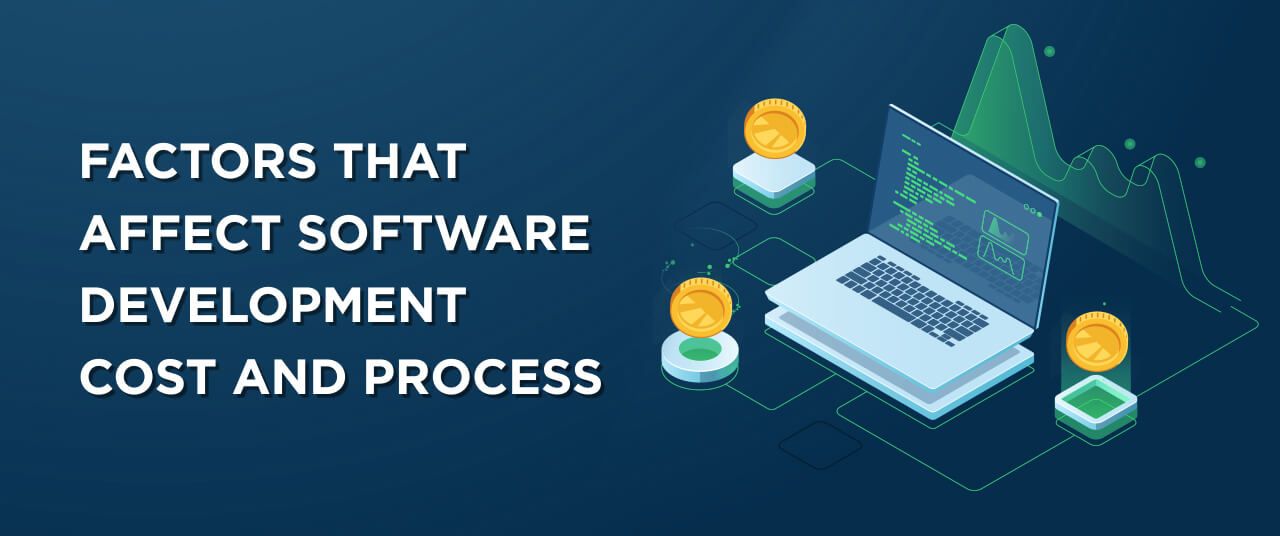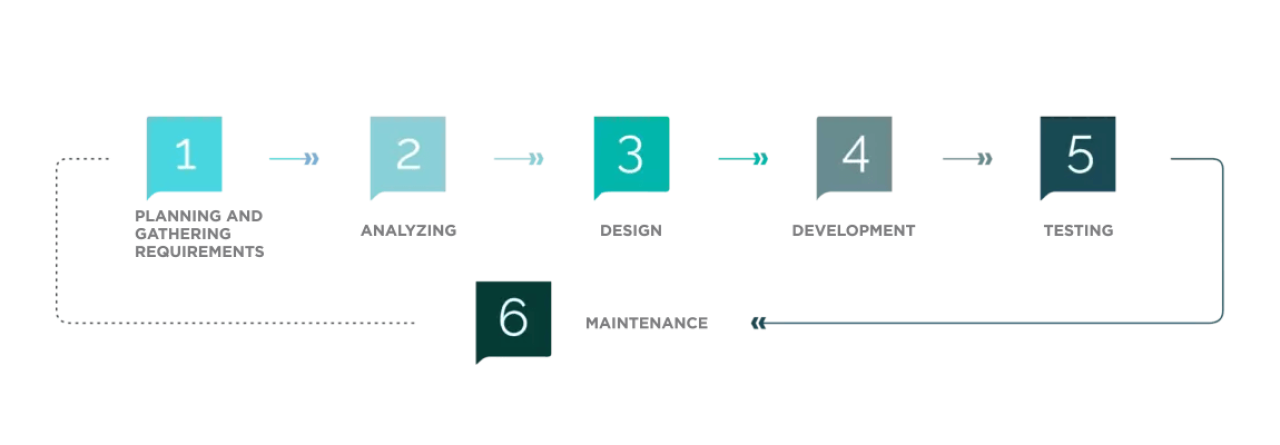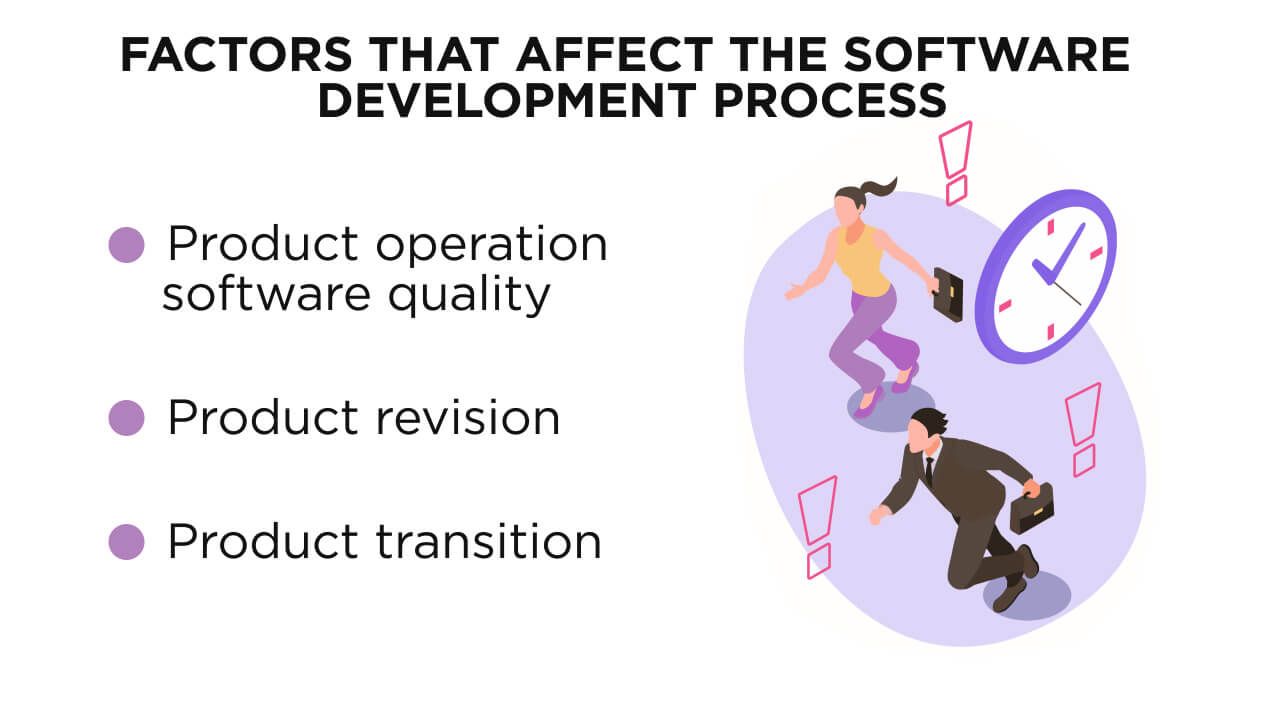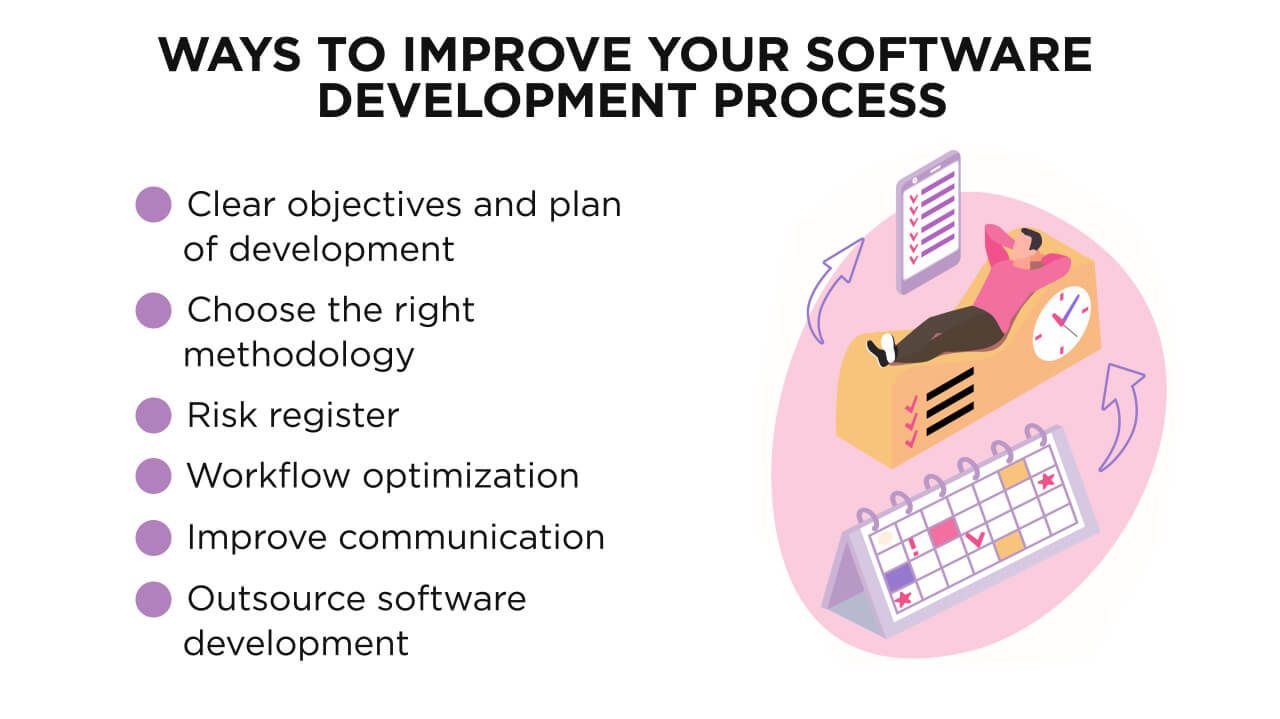Factors that Affect Software Development

Building custom software is a big decision. The success of your business directly depends on the performance of your application; thus, the development process should be taken seriously from the beginning.
Not everyone considers risks related to poor user experience or persistent software bugs — but both lead to wasted money. To avoid these issues, one needs to understand the importance of the relationship between the development process and cost. Naturally, every project is unique, as is the price — but for your business prosperity, it is crucial to understand which key factors affecting software development.
We are going to highlight and describe in detail the main factors that affect software development pricing. By the end of the article, you will have a better understanding of the development process and will be able to estimate potential project costs.
Here’s What We’ll Cover
Average Cost of Software Development
The average software development cost depends on various aspects, including the application’s type, its complexity, and even your team’s location. For example, a developer’s hourly wage strongly depends on the level of expertise — one can be a junior, middle or senior developer. It dramatically impacts not only the hourly rate of each specialist but also the quality of the product. Another factor is the location: experts in Romania would charge you less than ones in the UK, for example.
A less popular option is to hire developers at a fixed rate. This payment model makes it easier to estimate the budget. Furthermore, the client doesn’t need to be involved in the process and control it after the plan is approved. Although in this case, the project is less flexible since the customer doesn’t pay for actual work. For instance, an experienced developer might complete a task in two days, but despite that, his work was paid for the whole week. Thus, a fixed payment turns out to be unprofitable for the client.
Depending on the software’s type and size, the time to develop the product may take from 1 month to more than a year. For example, it can take weeks and $3,000 to implement some minor modifications into existing software. At the same time, to develop a new app of medium complexity from scratch, you would need an average of about 2+ months and up to $100,000.
Main Factors That Affect Software Development Cost
As mentioned before, app development pricing varies according to different factors. Here are some highlights you need to consider while estimating a budget for new software:
- Platform type
- Project type
- Software size and complexity
- UI/UX design
- Integration with existing or external systems
- Development team
- Testing
We’re going to focus more on each factor to give you a clearer idea.
Platform
The choice of the platform should depend on your business sector, the product’s type, and the required technologies. Even the target audience’s location plays a role here: in some countries, Android is more popular than iOS, and vice versa. Your choice of software development platforms will affect the software’s success and, obviously, the development cost.
According to a survey from Goodfirms, you would pay an average of at least $27,000 for a simple native app developed from scratch. Keep in mind that a cross-platform app often costs half as much as a native one. But again, the price may differ depending on the country. For instance, the same statistics say that Indian developers can build a simple cross-platform app for at least $8,000, while their Canadian colleagues would charge you roughly $34,000.
Native Application (iOS/Android)
A mobile app running on one specific platform has its pros and cons. For instance, since the development team uses programming languages and tools that are made exclusively for iOS or Android, it almost guarantees better performance and user experience. On the other hand, how do you select the right platform? One may rely on GlobalStats data saying that Android is used much more frequently than iOS. If you want to get two native applications for both platforms, the process might take more time and money, as you need to hire two different teams.
Cross-Platform Application
You only need one team to develop an application that works on both platforms. It is cheaper, less time-consuming, and helps you reach out to a larger audience. Although sometimes, these apps have compatibility issues and other bugs, so they need to be well-maintained. It is a less popular choice among specialists: according to Statista, roughly 30% of mobile developers work with cross-platform technologies rather than native tools. In 2021, as well as a year ago, the leading positions are held by the Flutter and React Native cross-platform frameworks.
Web Application
Web applications are easier and faster to develop, and that affects the price. They don’t need to be submitted to any app stores and can be updated automatically. The downside of web apps is that they are considered to be slower and less functional than mobile apps. However, today, there are progressive web applications that have some mobile app features. They run faster than standard web apps and can even work offline.
Type of Software Project
The category of the software project defines what kind of specialists you need to hire, as well as how much money and time it will take.
These are the main types of projects:
- New software development. It is about creating a custom product from scratch. Therefore, it’s the most expensive type and requires a significant budget.
- Existing software modification. This job is to apply necessary updates and other adjustments to improve old software.
- Software integration. It’s when you already have software that needs to be implemented into other processes. Microsoft Office is one of the examples of software integration.
- Web development. You hire developers to build a new web application or a website.
Software Size and Complexity
Price estimation would be impossible without understanding the scope of work. This factor depends on how big and complex the future product should be. Note that large projects are not always the most difficult ones.
Overall, there are four common project sizes:
- Small. It usually means that one needs to apply insignificant changes, such as fixing some bugs.
- Medium. It is often about creating a simple mobile app or a web interface. For example, a basic application can be built in 500 hours.
- Large. These projects, by default, require more expertise, time, and money. This can be the development of a multicomponent application that runs across various platforms and needs to be integrated into many systems. The job usually takes up to one year.
- Enterprise. The largest projects fall into this category. They may require serious security features, reliable databases, error handling, and scalability. The development process often includes integration into multiple systems. Sometimes, it takes more than one year to deliver a high-quality product of this type.
UI/UX Design
One shouldn’t underestimate the importance of visual components. The interface of your app is the first thing that users see. The impression they get will influence their decision to stay or leave; hence, your product’s success depends on it. Software design and architecture play crucial roles in delivering the best user experience. It is meant to satisfy users’ expectations and needs effortlessly. At the same time, UI/UX design helps to combine the aesthetic side with responsiveness, functionality, and usability.
Integration With Existing or External Systems
Software integration provides smooth communication between programs by unifying different subsystems and synchronizing their work. For example, it may be necessary while moving from a legacy system to an updated database system. Another case is to link different programs performing various tasks so they can work together and produce uniform results. Well-known examples of software integration are Microsoft Office and Google Suite.
Here are the most common integration types:
- Third-party software integration. This is when developers take an existing solution and implement it into your application. It saves both time and money. It is widely used by eCommerce, payment, and social network apps when one needs a multifunctional application that can process and analyze various data.
- Internet of Things (IoT) integration. This one helps the business to grow by analyzing the data collected by IoT devices. This integration type is useful for large organizations that need all their systems to work in tandem without losing any important information.
- Artificial intelligence (AI) integration. Integrating AI into the system means creating custom software features such as voice or face recognition.
- Application integration. Business uses it for various purposes — for instance, to build a sort of bridge between old on-premise and new cloud applications.
The integration complexity depends on the type of software that needs to be integrated, the data source size and type, and the number of systems that the company uses. Besides, the integration can be negatively affected by differences between application standards — proprietary or open-source ones. This complicates the process of exchanging and sharing data between systems. Although, this issue can now be solved using an Application Programming Interface (API).
Development Team
The project’s complexity determines the kind of team you need. One wouldn’t hire a senior developer who charges an average of $45 per hour to create a basic app if this task can be done by a junior or middle-level specialist who charges $20-35. It is simple math: the more sophisticated software you have in mind, the more experienced the team you should hire, and the more money you’ll have to spend.
Bear in mind that the development team doesn’t just consist of different kinds of developers. There are also engineers, UI/UX designers, a project manager, a team lead, a product owner, and testers. The trick here that is being used by large companies is outsourcing. It is a well-known fact that due to various economic factors, IT specialists from Eastern Europe are more affordable than their colleagues from the USA. And yet, they are highly skilled and trustworthy.
Testing
The testing phase is one of the cornerstones for receiving the best product that meets all requirements and is bug-free. A series of tests can be performed manually or using automation tools. On average, a testing service costs around a quarter of the entire project’s price.
The amount of testers you need in your team depends on the project’s type and complexity. For example, you might need up to 10 experts to test a medium-sized application built from scratch. You should also consider risk-based testing, which helps you identify crucial features that tend to fail and prevent them from doing so once the software is released.
If you want to save some money and time, it is advised to test your product as often as possible. The earlier you find a glitch, the easier it is to fix. Besides, even at this stage, outsourcing is a cost-effective solution in the long term. Independent testers from third-party companies with the right set of skills can perform a better job from outside of the project.
Tips for Reducing Software Development Costs
When calculating a project’s price and selecting an outsourcing company, it is easy to make a mistake. Here are some tips to help you organize the process properly without overpaying:
- Create a technical specification.
- Develop essential functions.
- Hire experienced developers.
- Develop an MVP.
- Use a back-end as a service solution.
- Take advantage of ready-made solutions.
- Use cross-platform development.
- Choose a suitable software development approach.
- Test from the early stages.
Further relevant information may be found in this article.
What Is the Software Development Process?

The so-called software development life cycle consists of various stages. Different sources describe them in different ways. Usually, the software development process includes the following steps:
- Planning and gathering requirements. A client shares their idea, and the hired team comes up with a plan according to the client’s requirements.
- Analyzing. Stakeholders discuss the technical and user sides of the project. As a result, the team realizes the scope of work and gets a detailed description of each component.
- Design. Developers and architects design a template of a future product considering the client’s budget, time, suitable technologies they are going to use, front-end representation, and other factors.
- Development. Developers start coding based on the agreements from the previous steps. They create necessary components and features of the future product.
- Testing. Experts test the software’s performance, detect bugs and other possible glitches, and share the results with the development team.
- Implementation and deployment. The software is installed following the implementation plan. Depending on the project’s complexity, the release can be done immediately or in stages. After this stage, users finally get access to the app.
- Maintenance. This part includes regular updates. This is an important stage, as here, the app can be upgraded and polished according to real feedback from end-users.
Factors that Affect the Software Development Process

According to the well-known McCall’s Factor Model, there are three factors affecting the software development process that you should know:
- Product operation software quality
- Product revision
- Product transition
Now, let’s dive deeper into each of them.
Product Operation Software Quality Factors
This group emphasizes the importance of a software’s performance and user-friendliness. It detects any tendencies to fail and monitors that the product meets all client’s requirements. This factor includes such aspects as correctness, reliability, efficiency, integrity, and usability.
Product Revision Quality Factors
This group is about how complex it is to maintain the software. Also, how flexible is this app in adapting to adjustments. These factors include the testing capacity of the software. It shows us how much effort it takes to ensure the product’s quality and to keep it away from failure. In general, there are 3 points here: maintenance, flexibility, and testability.
Product Transition Factors
These quality factors indicate the software’s integration ability — how the product interacts with other applications and adapts to different environments (device, OS, hardware, etc.). Three elements you need to focus on: portability, reusability, and interoperability.
Ways to Improve Your Software Development Process

Here are some useful tips on how to improve the software development process:
- Clear objectives and plan of development. Unclear requirements often cause a project to fail: it is difficult to create a decent product without understanding its conditions and goals. It is crucial to involve all stakeholders in the discussion and cooperate closely with the development team.
- Choose the right methodology. It provides a discipline and an efficient approach to software development. Ignoring methodology can cause misunderstandings between the client and development teams. In turn, this leads to wasted time and money, and the final project will fail.
- Risk register. It is vital to create a list of risks to detect and classify potential technical problems and other risks in the future. This helps to predict and avoid them. The project manager should be the one taking care of it.
- Workflow optimization. When applied properly, an optimized workflow will keep your team focused and efficient. There are no miscommunications: each team member is aware of their role, and time and resources are spent efficiently.
- Improve communication. A good work environment is important while different specialists are working on the same project. In this case, success can only be achieved when there is well-established communication and full mutual understanding within the team.
- Outsource software development. In 2021, the preferred destinations are India, Asia, and Eastern Europe. Thus, companies reduce the software development cost and receive a high-quality product from the world’s best experts.
Summary
It is impossible to predict the precise cost of software development. However, when you know all the factors and keystones that form the price, you shouldn’t encounter any difficulties or unpleasant surprises while estimating a budget.
In our video below, we share some key points of the article that you can take to get ahead.




